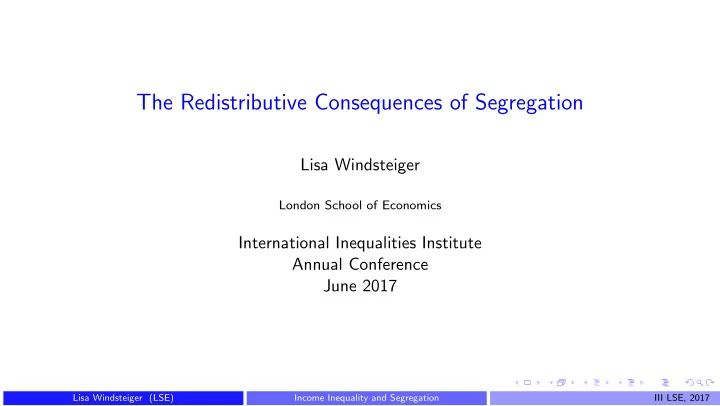

The Redistributive Consequences of Segregation Lisa Windsteiger London School of Economics International Inequalities Institute Annual Conference June 2017 Lisa Windsteiger (LSE) Income Inequality and Segregation III LSE, 2017
The Question Why do we in general observe a non-monotone relationship between income inequality and support for redistributive policies in society? Income inequality has increased in many (industrialized) countries over the last 40 years (see Piketty, Saez, Zucman,..). In general, demand for redistribution in society has not exhibited the same trend (see Ashok et al. (2015)). Lisa Windsteiger (LSE) Income Inequality and Segregation III LSE, 2017
The Question Socio-economic segregation is high in areas where inequality is high (Reardon and Bischoff (2011), Chetty et al. (2014)). Misperceptions of the income distribution (own survey, Norton and Ariely (2011), Cruces et al. (2013)) Lisa Windsteiger (LSE) Income Inequality and Segregation III LSE, 2017
Putting the pieces together People are segregated according to income. They are biased about the overall income distribution. This affects people’s support for redistributive policies. Lisa Windsteiger (LSE) Income Inequality and Segregation III LSE, 2017
Results Demand for redistribution is lower than without segregation and misperceptions. An increase in inequality always leads to a smaller increase in demand for redistribution and can even lead to a decrease in demand for redistribution. Lisa Windsteiger (LSE) Income Inequality and Segregation III LSE, 2017
Empirical Evidence Lisa Windsteiger (LSE) Income Inequality and Segregation III LSE, 2017
Own Survey Do people have biases of the kind that I assume in my application? Is the severity of misperceptions correlated with segregation? Lisa Windsteiger (LSE) Income Inequality and Segregation III LSE, 2017
Own Survey Conducted in the US via Amazon Mechanical Turk, 600 respondents Ask about own household income and certain (perceived) characteristics of the income distribution Ask questions to figure out their degree of (socio-economic) segregation more Lisa Windsteiger (LSE) Income Inequality and Segregation III LSE, 2017
Misperceptions of average income People’s estimate of average income is increasing in their own income (Bias = perceived average income - correct average income) 100000 50000 0 -50000 -100000 0 20 40 60 80 100 Income percentile Fitted values Bias Lisa Windsteiger (LSE) Income Inequality and Segregation III LSE, 2017
Social segregation I Lin Position Generator Question: Assign CAMSIS (=Cambridge Social Interaction and Stratification) score to each profession and calculate respondent’s standard deviation Lisa Windsteiger (LSE) Income Inequality and Segregation III LSE, 2017
Social segregation II Ask about household income and education of social circle ◮ friends ◮ family ◮ work Construct a measure of social segregation via factor analysis Lisa Windsteiger (LSE) Income Inequality and Segregation III LSE, 2017
Misperceptions and segregation People with a more diverse social circle tend to be less biased about average household income Lisa Windsteiger (LSE) Income Inequality and Segregation III LSE, 2017
Conclusion Model of segregation with misperceptions, interaction of beliefs and segregation Non-monotone relationship between inequality and demand for redistribution Empirical analysis to investigate relationship between segregation and misperceptions Outlook: ◮ Extend empirical analysis, especially to European countries Lisa Windsteiger (LSE) Income Inequality and Segregation III LSE, 2017
80 60 Frequency 40 20 0 0 50000 100000 150000 200000 250000 Income Figure: Sample household income distribution Lisa Windsteiger (LSE) Income Inequality and Segregation III LSE, 2017
6.00% 5.00% 4.00% Figure: US household income distribution back Lisa Windsteiger (LSE) Income Inequality and Segregation III LSE, 2017
(1) (2) Bias2 Bias2 Social circle status diversity -0.0107 ∗∗∗ -0.00916 ∗∗ (0.005) (0.015) Income percentile -0.00181 ∗∗∗ (0.000) Intercept 0.483 ∗∗∗ 0.568 ∗∗∗ (0.000) (0.000) N 592 592 p -values in parentheses ∗ p < 0.10, ∗∗ p < 0.05, ∗∗∗ p < 0.01 Lisa Windsteiger (LSE) Income Inequality and Segregation III LSE, 2017
Bias Income percentile 0.004 ∗∗∗ (0.001) (Income percentile) x (Social segregation) 0.002 ∗∗ (0.001) Social segregation -0.073 (0.060) Intercept -0.598 ∗∗∗ (0.041) 592 N p -values in parentheses ∗ p < 0.10, ∗∗ p < 0.05, ∗∗∗ p < 0.01 Lisa Windsteiger (LSE) Income Inequality and Segregation III LSE, 2017
Recommend
More recommend